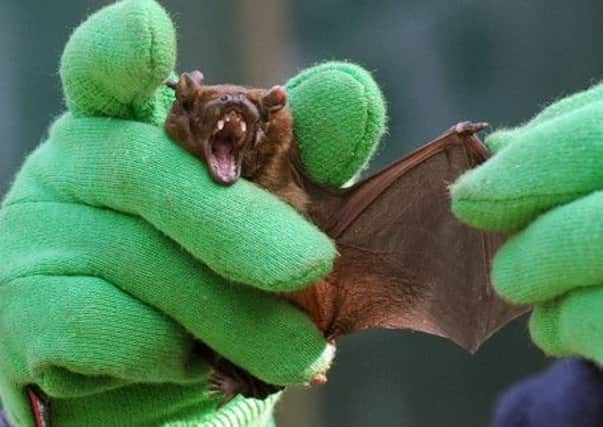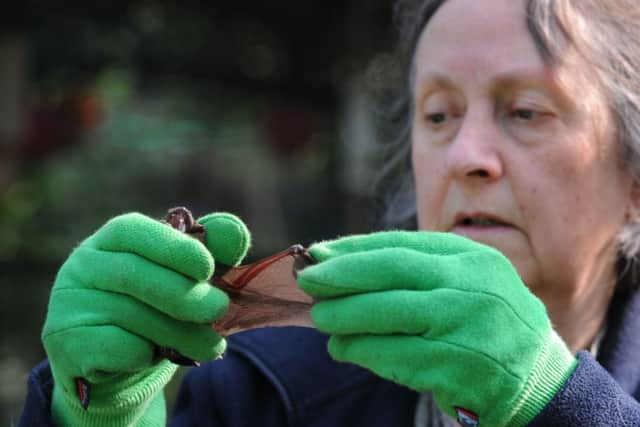Into the bat cave: Neither undead nor unloved


It’s always a problem, working out what to do with the pets at holiday time, so Maggie Brown used to take them with her. So that was her, husband Bryan, the two girls – and the bats; all heading for the holiday cottage on the west coast of Scotland. These days she arranges sitters – what else to expect from a woman who is so immersed and so expert in the world of bats?
Maggie, a retired teacher of Otley, near Leeds, has run the West Yorkshire Bat Hospital for decades, has a masters degree in their local habitats, has written a manual on their care, has received an award for her bat work, and generally gives over much of her life to the rescue of the creatures so often demonised in our culture.
Advertisement
Hide AdAdvertisement
Hide AdMany people fear bats, have been known to run screaming and naked from their home at the sight of them, in the experience of those in the business of bat rescue. Bats are creatures of the night, they have teeth, they fly on dragon-like wings – and Dracula could turn himself into one. And if they don’t fear the animals themselves then people fear the legislation surrounding and protecting them.


But for Maggie, it is different.
“It is the greatest feeling in the world when you let them go,” she says. “The first time I released five babies back into the wild it felt just like when I allowed my daughters to go into Leeds on their own on a Saturday night. I was terrified. Luckily both my daughters and the bats were fine.”
In fact, daughters Hannah and Sarah, now 32 and 31 respectively, are understanding of their mother’s passion, and are the ones who will take over the feeding on occasion.
But, lest you get the wrong idea, It isn’t all cute and fluffy in Maggie’s world. Many of the rescued bats die, and if a bat is too injured then she will put it down herself, breaking its neck.
Advertisement
Hide AdAdvertisement
Hide Ad“Some people will never put a bat down, but I believe it is sometimes kindest. About 40 per cent of the bats that come to me will die overnight anyway. If they are very injured they can just give up and refuse to eat.”
Maggie also runs West Yorkshire Bat Group, helping to train bat carers – so it is a little ironic that it was her husband, now a retired art lecturer, who became the enthusiast first, but then went on to develop an allergy that made it impossible for him to continue.
Their story began back in the 1980s when neighbours found an injured bat on their doorstep.
“They couldn’t cope with fur or feathers so they brought it round to Bryan. He had an interest in exotic animals and they thought he might know something about it,” says Maggie.
Advertisement
Hide AdAdvertisement
Hide AdAnd that was the beginning of that. The very first bat died, and so did the second they tried to help, but gradually Bryan became involved in West Yorkshire Bat Group.
At the time Maggie was at home looking after two girls under school age, and bats were not her priority.
“I was a little bit scared of them at first, although they are tiny they can shout a bit.”
But gradually Maggie became more involved, just as Bryan was forced to become very much less involved – for reasons to do with mealworms.
This next bit is not for the squeamish.
Advertisement
Hide AdAdvertisement
Hide AdIn the wild bats eat flying insects but it isn’t possible to collect enough for them to eat in captivity.
Maggie does her best, going out into the woods and sweeping nettles, then collecting whatever insects are revealed in an old laundry basket, but mostly it is mealworms. Some £50 a month from the housekeeping is spent on them, more than Maggie and Bryan sometimes spend on their own food.
To get the bats used to them initially, a worm has to be decapitated and have its innards squeezed out all the better for tasting. Maggie now uses tweezers to do this job, but in the old days Bryan would use his fingers. One day the innards squirted into his eye, which the couple believe triggered an allergy.
So now the job is Maggie’s. She has eight bats in permanent residence because they are too disabled to fly. In fact, she does not regard them as pets, saying they maintain their wildness even in captivity and her aim is always to rescue, nurture and release. She has taken in 75 bats this summer and at the moment has 20 in a huge flight cage in the garden, preparing for release.
Advertisement
Hide AdAdvertisement
Hide AdBats hibernate in winter, but Maggie’s summer is particularly hectic. Her phone – yes, let’s say it just once, her batphone – can ring at any moment and an injured client can turn up on her doorstep at any time.
The bat she is most likely to be handed is a pipistrelle, the most common species in Yorkshire. The biggest she has in her care is a noctule, which is the size of a small mouse.
Whatever the species, the aim is to rehydrate it and stuff as many calories into it as possible. Babies are fed every two hours on puppy milk from 6am to midnight. It takes pretty much two hours to complete the task, so the work is continuous.
But Maggie is not alone in her work, as there is a whole network of Yorkshire people ready, willing and able to rescue bats.
Advertisement
Hide AdAdvertisement
Hide AdEd Sherratt, 35, is vice-chair of West Yorkshire Bat Group and one of a total of 25 carers in the area. He became interested in bats some eight years ago through his partner Michelle, who works for Natural England.
“I was going along and dropping her off when she was doing night-time surveys. If you are a man sitting on your own in a car park you are going to be regarded with some suspicion, so one night I got out of the car and decided to help her.”
That desire to avoid looking a bit dodgy led to a bat passion and Ed joined around a hundred other people in West Yorkshire Bat Group. As well as carers there are “ambulance drivers” who will go out and collect an injured bat from wherever it is found.
The work involves a great deal of commitment, including an anti-rabies injection, since one species of bat – the Daubenton’s – can carry a virus that is a strain of rabies. Only ten individual bats have been found to carry the virus in the UK and the species does not typically roost in houses, so incidences of it being passed to humans are rare, but all those who work with bats have to be protected. A licence is also required before a carer is allowed to disturb bats.
Advertisement
Hide AdAdvertisement
Hide AdSo can a householder ever, under any circumstances, have bats removed from their home?
Ed says: “Only if they have a genuine phobia. But the thing about bats is that they don’t do any damage. The best thing truly is to just let them be. They don’t chew things, they don’t bring stuff into your loft or your attic. They are not even there all the time, they come and go.”
Compromises can be reached. If bats are in a difficult place, causing noise disturbance for instance, then bat boxes can be provided on the outside of the house instead.
Ed’s job is basically to act as a PR man for bats, improving their image by enlightening us as to what they are really like.
So here are some bat facts that not a lot of people know:
Advertisement
Hide AdAdvertisement
Hide AdBats are mammals and give birth to surprisingly few young. A pipistrelle may live for 15 years but have only three babies, always one at a time. They tend to give birth in June around Father’s Day.
A quarter of the world’s mammals are bats
Bats are fastidious and do not like to foul their roost. They eat outside and tend to leave their droppings outside, unless they are babies. Basically, they are in your house just to sleep.
Bats will have several roosts so if they live in your loft they are likely to be there only for a few days at a time.
Bats make social noises that we can hear, and others that we mostly can’t. They navigate using echolocation, bouncing ultrasound off objects. Some people, particularly the young, can sometimes hear the lower ranges of this ultrasound, but older people are oblivious. Cats on the other hand can hear it perfectly, making them big bat predators.
Advertisement
Hide AdAdvertisement
Hide AdMale and female bats live separately. The females live in maternity colonies of mothers and babies.
Bats are not blind, are not flying vermin, won’t fly into you, won’t bite unless attacked and are not particularly scared of people.
In fact, bats are pleasant little critters and when in care all tend to exhibit different personalities, but not everyone is convinced of their friendliness.
Ed says: “I have known people run out of their homes screaming at the sight of them, one woman ran out naked.
Advertisement
Hide AdAdvertisement
Hide Ad“Another time I went to collect a bat and it had been put in a box with a great pile of telephone books on top of it, as if it was going to punch its way out.”
Ed and Michelle have cared for five bats this summer and managed to release them all back into the wild after giving them some TLC. “We test fly them in the lounge first,” he said.
In general, the public is becoming more knowledgeable about bats, and more tolerant of them. Maggie says: “I give talks in schools, and often when I go in now the children will already know quite a lot about bats.”
Finally, here’s a tip: If you do find a bat where it shouldn’t be, wrap it gently in a tea towel, and hang the towel on the washing line at dusk so it can fly off in its own time.
But if that doesn’t work, or the bat is injured, telephone the Bat Conservation Trust helpline on 0845 1300 228 or the West Yorkshire Bat Group helpline on 01924 256577.